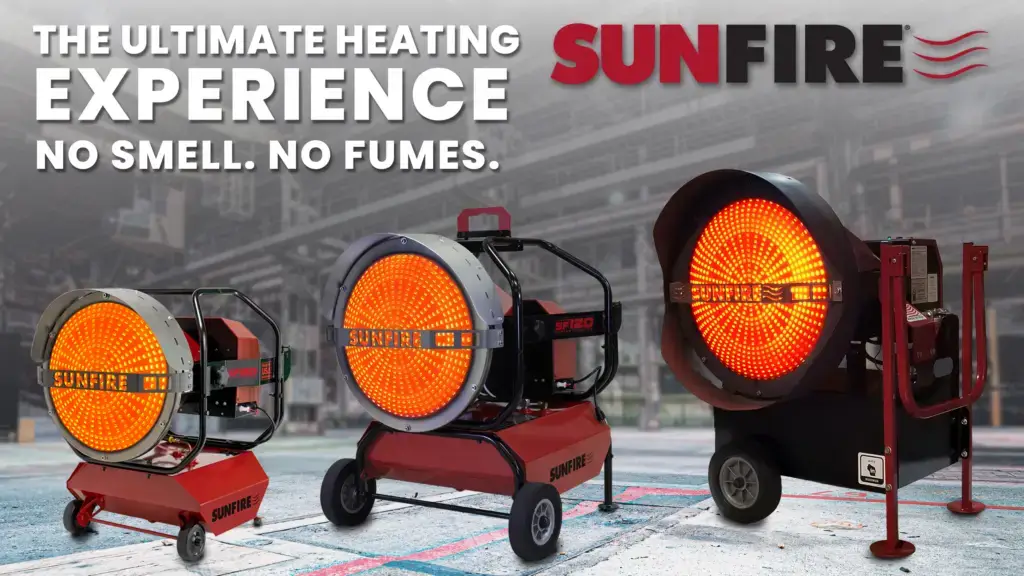Sunfire Radiant Heaters Explained
When deciding which SunFire Radiant Heater to go with, there are a few different things that stand out between the SF80, SF120, and the SF150. Choosing the right heater for your application not only helps keep workers safe and warm but can decrease the amount of money you spend on jobsite energy costs. We are here to help explain the differences between each heater so that you make the right choice for your operations.
About SunFire Radiant Heaters
Our heaters are built to last, made with heavy-duty steel and parts. They are perfect for extreme environments like construction sites, auto shops, outdoor events, pole barns, and garages. There is even a feature for you to hook up a mechanical or battery-operated wall thermostat so you can help regulate the temperature for a comfortable environment.
SunFire heaters are proudly built in the USA, in Janesville, WI, and are known for their durability and high-performance. There are three lines of SunFire heaters, the SF80. SF120, and SF150. Each heater has lower noise levels compared to forced air, and provides clean air with a pure, smokeless flame.
The Difference in SunFire Heaters: SF80, SF120, and SF150
To help you decide which heater will fit your operations, we’ve compiled a list of the biggest differences between our three radiant heaters.
- Size
When it comes to the size of each heater, the SF80 is the smallest and lightest option between the three. The SF80 is a little over 28 inches high and weighs only 127 lbs. with a full tank. The SF120 is slightly larger, just under 34 inches in height and weighs 219 lbs. with a full tank.
The SF150 on the other hand, is 41 inches in height and can weigh up to 320 lbs. with a full tank. Because these heaters can be heavy, they do come with wheels so you can easily move the heater if needed.
- BTU/Hour
The Sunfire heaters get their name from the BTU/Hour they put out. For example, the SF120 runs on 120,000 BTU/Hour, and the SF150 runs on 150,000 BTU/hour (on high). The SF80 runs on the lowest BTU/hour, at 80,000. Depending on the size of the area you are looking to heat, this may be one of the biggest factors in determining which heater to buy.
If you are looking for a heater that can do both, the SF150 does have a low setting on which it can run, where it will run 130,000 BTU/hour. This gives you the option to use it for both your larger and your smaller jobs.
- Fuel
Each heater has the ability to use diesel/#2 fuel or kerosene. The SF80 has a run time of approximately 10 hours, and can hold 14.2 gallons. When running diesel or No. 2 fuel in the SF120, the run time for the machine is 16 hours, and that number increases to 18 hours when using kerosene. The tank on the SF120 will hold 14.2 gallons.
For the SF150, the tank capacity increases to 19 gallons, and the run time of diesel and No. 2 fuel increases to 19 hours on low, and 17 hours on high.
Deciding Which Heater to Purchase
Now that we’ve gone through the differences in each heater, you hopefully have a better understanding of which one will work best. If you are still contemplating your decision, we can help. It’s important to know the size of the job sites you are trying to heat, as that can be one of the biggest determining factors in which heater you go with. For smaller sites, the SF80 or SF120 may do the job. But if you plan on having both small and large job sites, the SF150, with the capability to run low and high, may be a better choice.
If you have questions, you can always contact us to help make the right decision. If you are ready to buy, you can find out where to purchase them here, or find a dealer to help you get going. Whatever you choose, SunFire heaters will help keep you warm.
